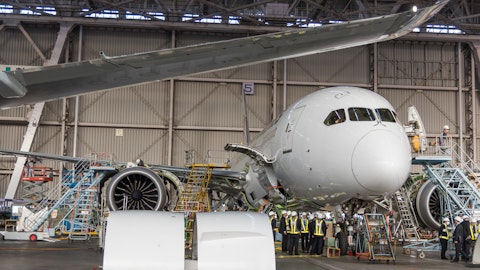Peter Arment: Phebe, maybe just to stay on Seth’s line of question just on Marine. Maybe you could just — there’s been a lot written about just the industrial base, and you just mentioned it. How are you thinking about just maybe the CapEx profile and in particular, things start to get unveiled on , what the plans might be there? Just should we expect any further step-up in CapEx ?
Phebe Novakovic: Not with respect to . And I think we have, as I’ve said on earlier calls and to many of you in person, we’ll just take our lead from our Navy customer on how they want us to respond to all of this. So this is really an intergovernmental series of discussions and agreements and we will, of course, support whatever the Navy plan is going forward.
Peter Arment: And just as a quick follow-up, just maybe just in general on the supply chain. You talked about the constraints in marine and some of the issues at Mission Systems. Has it gotten worse or do you think it’s actually kind of stabilized? And this is just — if is what it is, what’s going on in the marketplace?
Jason Aiken: So I think with respect to Mission Systems, we have to really focus on what it is we’re talking about here, which is really chips and microelectronics, right? So unlike some of the other parts of the business, which are heavily labor and availability of workforce driven. So this is really, obviously, for Mission Systems an issue that’s impacting industries much broader than just us or us in the aerospace and defense side. And I think when these issues first surfaced, Mission Systems did a really nice job of developing workarounds, right? Finding alternate sourcing, certifying substitute parts and so on. So all of those actions were predicated on the expectation that the supply chain would kind of come through this and get over the hump within, call it, a year plus or minus.
But frankly, as we’ve continued to work our way through it, it’s become clear that we’re not always at the top of the priority list for some of these sources of supply. So when they saw the bottlenecks we were dealing with were going to persist somewhat longer than expected, the team really adapted to this new normal with a whole new set of tactics. That includes procuring key components with longer lead times anywhere from 12 to 18 or even 24 months, as well as working with key suppliers to improve the forecasting that we were giving them and the reliability of demand so that they could have confidence in where we were going and allocate additional capacity to us and our priorities. So all of that is in place and underway. As you might imagine, some of those things take a little longer to yield results.
So that’s why we’re expecting that to kind of come through in the second half of this year. But we do feel like they’ve got a good plan in place, they’ve taken great corrective actions, and we just need to see that all sort of roll out and to get to the other side of this, but it’s likely to be toward the second half back into this year before that all takes hold.
Operator: Our next question comes from Ron Epstein with Bank of America.
Ron Epstein: You’ve talked about this a little bit in your prepared remarks about the impact that the Ukraine could potentially have on land systems. Maybe from a bigger strategic point of view, it seems like in the past, the logic has always been the Army was a bill payer for the Navy and the Air Force. Is that — are we learning a different lesson now out of the Ukraine and what kind of implications potentially does that have for your land systems business?
Phebe Novakovic: So if you look at the services funding over, I’d say, in the modern air post World War II, the Army gets funded when they’re tactical challenges and tactical problems, either a hot war, relatively cold war or preparedness, this is an issue where we’ve got both strategic challenges in which the Navy and the Air Force tend to get funded. And as I noted, the threat environment has materially changed. So that has driven increased interest in a number of Army and land forces capabilities. And as we’ve begun to see those show up in our in our backlog and in our order book, but we’ve got more room to grow and more room to go there as some of this demand converts into into actual orders. So when I think about what’s going on in Europe, our European combat vehicle business has done quite well in securing a number of contracts, both historically but increasingly recently and on a — what we expect on a going forward basis.
They’ve been active in Poland, Romania, Switzerland, Germany, Denmark, Spain, Sweden, Luxembourg. By the way, I wrote all those down because that’s a lot of countries. So I think the closer you are to the threat, the more urgent you feel your funding requirements. So all of which is to say, we have changed our expectations for Combat Systems growth. By the way, overarching all of this is a need to increase our ammunition and projectile output, and we’ve been working with the Army for the last three, four, five months on exactly that kind of plan. So as we’ve always positive, the threat environment really drives demand for defense products and we’re seeing some of that now.
Operator: Our next question comes from Jason Gursky with Citi.
Jason Gursky: Jason, I want to take the opportunity to ask you a question about the Technologies Group. I know you’ve been in the seat for just a small amount of time, but I’m maybe curious to know as you settle into your seat, the kinds of investments that you think you might want to make either in technologies or new products and services or in processes in order to accelerate revenue. Just kind of get your first impressions on the needs there in the group and what might change with you now taking over leadership of that group.
Jason Aiken: So I think the way to think about this group between GDIT and Mission Systems, technologies taken together, is that we currently are and have been for quite some time, in a model and of the capability set that a lot of the peer companies out there are trying to get to. That is a well balanced and comprehensive set of offerings between the traditional federal IT services offerings as well as cyber, hardware and other elements of that portfolio. And so I don’t think we have to necessarily play catch up as much in that game. I think there’s always opportunities to refine and enhance the portfolio. As I mentioned earlier, this is not going to stop being a dynamic environment. We are, as always, have continued to invest internally in new technology capabilities, that will continue to be the case.
As you know, I’ll say what I know Phebe would say if she were talking right now. We’re not going to speculate about M&A. There’s always the possibility for bolt-on acquisitions. I would note, by the way, since you brought up the point that since we acquired CSRA in 2018 and essentially transformed the face of this group with the size and capability of our federal IT services business. There have been — if I look at GDIT’s competitor group, call it, the top five or six main peers, there have been some 40 to 45 acquisitions in that space that those companies have taken on and we have not done any. We’ve done a couple of small bolt-ons in Mission Systems during that time, but nothing in GDIT space. And so it’s interesting to see how the others are behaving in the aftermath of that activity and a lot of the consolidation that’s happened in the industry.
But I think we put ourselves in very good stead and we see a lot of a lot of others following suit. So I don’t think there’s a massive sea change in what we have planned ahead, but we’ll continue to focus on maintaining our leading position in the market.





